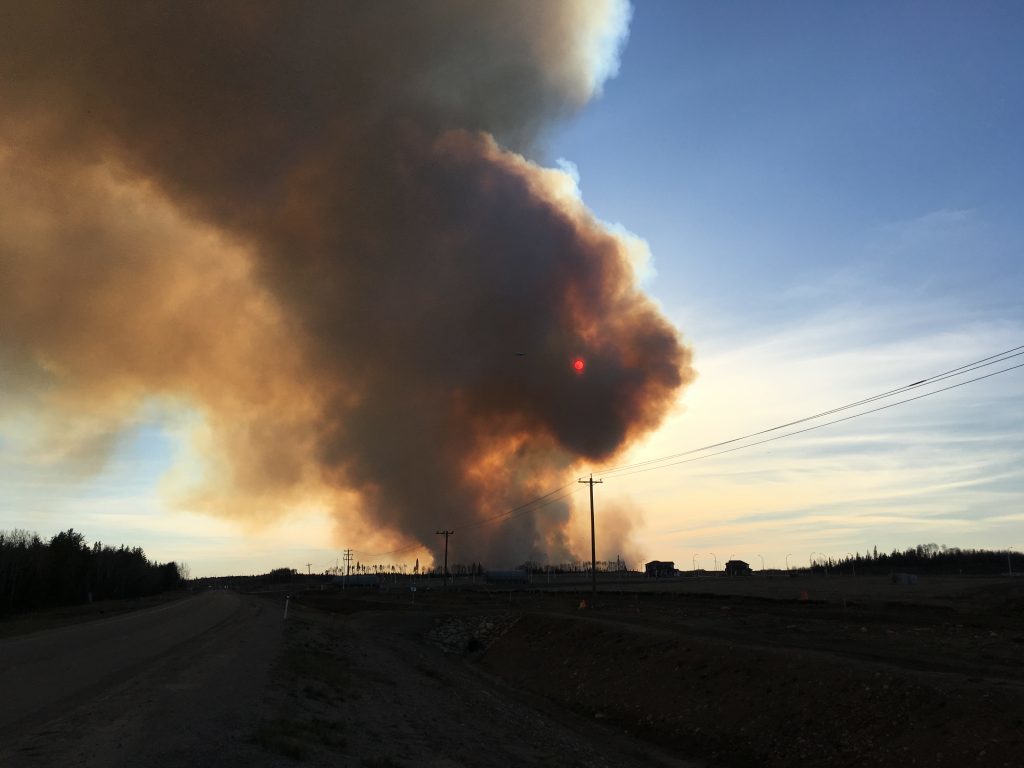Are newsrooms prepared for increasing natural disasters in Canada?
On Canadian Soil
It was the day Fort McMurray, Alberta, was evacuated because of the crackling, rapidly moving wildfire when Metro News decided it needed to cover the story. Many people who were required to leave Fort McMurray fled to nearby cities Edmonton and Calgary or had ties there. It was the paper’s first time covering a natural disaster, and Metro managing editor Angela Mullins was in command, running the show from Toronto’s newsroom (Metro has since rebranded to StarMetro in five Canadian cities, including Edmonton, Calgary, and Toronto). As the fires spread and forced people out of their homes, Metro monitored the coverage coming in through the wire services. But for Metro, something was lacking from the reporting: the wildfire’s human impact. With this objective in mind, Mullins put Metro’s reporters in Edmonton and Calgary on the story. The paper sent one reporter and photographer from the Edmonton office, while Calgary handled the phones.
Metro was out of its element. Its primary focus had always been city reporting. Covering a natural disaster was new and had different requirements than the standard municipal stories. Safety, food supply, and adequate accommodations were all concerns that needed to be taken into account. But Metro’s sudden movement to cover the Fort McMurray fire is emblematic of a broader Canadian story. Natural disasters are perceived to be phenomena that happen in far-off places. When they happen, editorial teams at media companies with budgets and an international presence dispatch reporters to parachute in and cover disasters for as long as the news cycle can afford to. But disasters are occurring with greater costs and frequency in Canada, and newsrooms across the country aren’t always prepared to best cover them. Last summer, B.C. experienced its worst wildfire season in history. The Fort McMurray fire was one of the worst natural disasters in Canada, with the financial impact totalling nearly $10 billion. In 2013, there were massive floods in Toronto and Alberta, where three people died. And, in February, a state of emergency was declared in Chatham-Kent, Ontario, due to immense flooding.
While it’s difficult to link one isolated incident to climate change, the big picture of Canada’s weather patterns tells a story of increasing temperatures and extreme weather events. Canada will warm more than the global average, and by 2050, summer and winter temperatures will reach new heights. “The frequency and magnitude of these disasters will both go in a negative direction,” says Blair Feltmate, head of the Intact Centre on Climate Adaptation. “Things are going to get worse.” Disasters like flooding, wildfires, extreme heat, and permafrost loss are all imminent in Canada, which will require increased resources from newsrooms to report on these events and their effects.

In 2016, Fort McMurray, Alberta, experienced one of the worst natural disasters in Canadian history. In the coming years, wildfires in Canada are predicted to increase. (Flickr/jasonwoodhead23)
“I think we’re covering it more and more whether we recognize that we’re covering it or not,” Mullins says, citing the floods on the Toronto Islands during the summer of 2017. “I think we’re all going to have to get used to this being the new norm, and it’s not just house fires and murder scenes anymore that are breaking news,” she adds.
The Canadian Arctic is already experiencing devastating effects. Sea level and temperatures are rising rapidly, which is disrupting many northern and Inuit communities’ ways of life. Melting permafrost has been detrimental to community infrastructure, food, and culture.
In the north, people use ice as a highway, says John Smol, a Queen’s University professor and the Canada Research Chair in Environmental Change. “We hear about the ice roads going north that they can’t use anymore because they aren’t safe enough,” he says, adding that it’s also increasingly difficult to hunt on sea ice, creating the need to buy food from stores. “That is an economic issue, but it’s also a health and cultural issue.”
According to the Nunavut Climate Change Centre, Inuit elders have witnessed changing cloud and wind patterns, which has greatly influenced how they live on the land they are so deeply connected to.
“The stability of their housing that’s dependent on permafrost being in the ground…the foundations…are eroding away, and literally the houses are falling out under their feet,” Feltmate says. “I don’t believe people in southern Canada fully appreciate the degree of disruption that First Nations, Inuit, and Métis are realizing due to climate change under conditions whereby they were stressed to begin with.”
Johanna Wagstaffe works as a broadcast meteorologist for CBC Vancouver. Over the course of her 10 years in the profession, she says she has been reporting on more severe weather events. “As a meteorologist, when I am looking at the numbers, that backs up what I’m seeing as well,” Wagstaffe says. Last June, she shepherded a six-episode podcast called 2050: Degrees of Change, which told the story of how climate change will look in B.C. in 2050 if the global carbon emissions are cut in half and on track in staying stable. Wagstaffe found there will be more climate refugees, heat waves, forest fires, and threats to the fresh water supply, among other effects.
Over the course of the last 113 years, Feltmate says, southern Canada has seen 18 percent more rain on average annually, meaning that some areas receive less while others receive more. “The weather that occurs now that is typical of regions, generally speaking, climate change exacerbates it,” he adds.
One major risk that will arise in the coming years because of climate change is basement flooding, which has a number of financial and social costs. “People are finding that they can no longer buy insurance to cover their homes for flooding,” Feltmate says, adding the average cost that comes from a flooded basement is between $42,000 and $43,000. Extreme heat also has detrimental effects, particularly on the elderly and people who can’t afford air conditioning, says Gordon McBean, a Western University professor and president of the International Council for Science. Food will be stressed. “You won’t be able to grow some things. It will be too hot,” he says. “With increasing, intense rain flood events, it may also directly affect…the growing situation, but will also affect the transportation—the processing of the food as it goes from, say, the field, to eventually the farm, to the store where you buy it.” Coastal areas are at high risk, too, McBean says, adding that Prince Edward Island could become Prince Edward Islands.
While climate change coverage is improving, it was previously riddled with false equivalencies that painted the deniers as legitimate sources. McBean recalls some years ago when he was asked to speak on a radio station in southern Ontario. The broadcaster wanted him to debate with a climate change denier, and McBean said he would only do it if there were nine other reputable climate scientists on the panel with him because that’s representative of how the scientific community perceives climate change. The radio station never responded. “When you look at the scientific consensus at about 99.9 percent and you look at what the general public thinks…it’s way off whack,” Smol says. “That’s been a well-orchestrated, well-oiled, developed controversy…I think the media had a role to play in fostering that.”
But nowadays, McBean says, the media is much better at telling evidence-based climate stories.
Human effects on the environment have mostly determined 2050’s climate, meaning how people act now will affect the world in 2100. “We could be looking at a really horrific climate change of four, five degrees Celsius warmer,” McBean says. “You’re looking at very major implications on the climate system, and as a result of that, major implications for our society globally.”
There are many issues that the government has to deal with, including the environment, economy, forestry, and natural resources, Smol says, adding climate affects all of these sectors. “It’s not a separate cost issue. It actually permeates the entire economy and everything in Canada,” he adds. In order to mitigate against climate change’s effects, Feltmate says, Canada needs to invest in adaptation strategies. “The return on investment for adaptation is astronomical on the plus side of the equation, and that’s what a lot of people simply don’t understand in the country.”
In coming years, it is expected that newsrooms will need to cover more stories of extreme weather events and climate change. There is a desire to understand how climate change influences the world, but people want to know why it’s happening, Wagstaffe says. “I think the science behind it is becoming more accessible and people want that,” she adds. “On the one hand, I think there is going to be a demand for more experts, and I think there is going to be a demand from reporters and journalists who are able to talk to scientists and be on the same page when it comes to climate change.”
The only way to learn how to cover natural disasters and extreme weather events is by doing it, Mullins says. “Every newsroom operates differently, and therefore because of that, the kind of disruption this causes in the normal is different for every group of people.”

